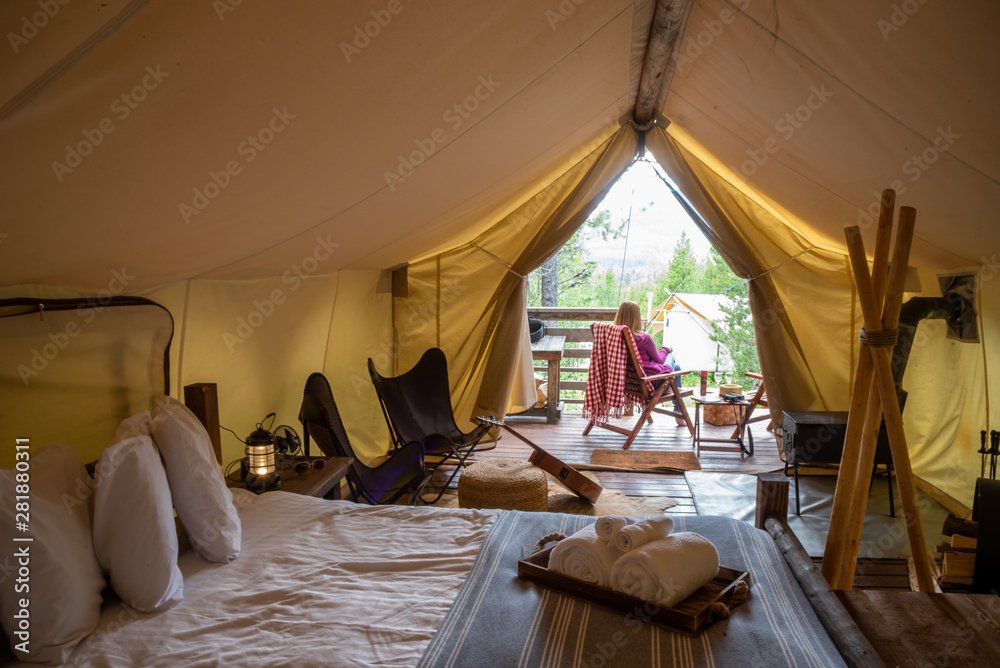Setting up a glamping business site involves careful planning, design considerations, and attention to detail. In this article; How to Set Up a Glamping Site, we will guide you through the process of creating a glamping site that offers a unique and unforgettable experience for your guests.

How to Set Up a Glamping Site
1. Site Selection and Preparation
Selecting the right location for your glamping site is crucial. Consider factors such as accessibility, natural beauty, proximity to attractions, and local regulations.
Once you’ve identified the ideal location, prepare the site by clearing any debris, leveling the ground, and ensuring proper drainage. Take into account the surrounding landscape and incorporate its natural features into your site design.
2. Accommodation Options
Choose the types of accommodations that will best suit your glamping site and target audience. Consider options such as safari tents, yurts, treehouses, or eco-pods.
Each type of accommodation offers a unique experience, so select ones that align with your site’s aesthetics and guest preferences.
Ensure that the accommodations are comfortable, well-equipped, and designed to blend seamlessly with the natural surroundings.
3. Designing the Layout ;How to Set Up a Glamping Site
Create a layout that maximizes space, privacy, and functionality. Consider factors such as the placement of accommodations, communal areas, amenities, and facilities. Design pathways that allow easy access to each accommodation while maintaining privacy.
Create communal spaces where guests can socialize, relax, and enjoy the outdoor environment. Incorporate outdoor living areas, fire pits, and dining spaces to enhance the overall glamping experience.
4. Facilities and Amenities
Offer unique and well-thought-out amenities and facilities that enhance the guest experience. Consider the following:
- Bathrooms: Provide clean and well-equipped shared or private bathrooms with modern fixtures and hot water facilities.
- Kitchen and Dining Areas: Create communal kitchens or dining areas where guests can prepare meals and enjoy shared dining experiences.
- Recreational Facilities: Incorporate recreational facilities such as hiking trails, swimming pools, sports courts, or wellness centers to cater to a variety of guest interests.
- Wi-Fi and Connectivity: Provide reliable Wi-Fi access to accommodate guests’ connectivity needs while maintaining a balance with the natural environment.
5. Sustainable Practices
Implement sustainable practices to minimize your glamping site’s environmental impact. Consider the following:
- Energy Efficiency: Utilize energy-efficient lighting, appliances, and renewable energy sources such as solar power.
- Water Conservation: Implement water-saving measures, such as low-flow fixtures, rainwater harvesting, and responsible water usage practices.
- Waste Management: Promote recycling, composting, and waste reduction strategies throughout your glamping site.
- Natural Integration: Embrace the natural surroundings and minimize disturbance to the ecosystem during construction and operation.
6. Safety and Security
Ensure the safety and security of your guests by implementing the following measures:
- Lighting: Install adequate lighting throughout the site to provide visibility and enhance security.
- Fire Safety: Implement fire safety measures, including fire extinguishers, clearly marked escape routes, and fire pits designed for safe use.
- Emergency Procedures: Develop comprehensive emergency procedures and communicate them to guests and staff.
- Guest Privacy: Design accommodations and communal areas to provide privacy and a sense of security for guests.
7. Landscaping and Outdoor Design
Enhance the natural beauty of your glamping site through thoughtful landscaping and outdoor design:
- Native Plantings: Use native plants in your landscaping to create a harmonious blend with the surrounding environment.
- Outdoor Furniture: Choose comfortable and durable outdoor furniture that complements the overall design and encourages guests to relax and enjoy the outdoor spaces.
- Pathways and Signage: Design clear and well-maintained pathways with signage to guide guests and ensure a seamless experience.
8. Guest Experience and Personalization
Focus on creating a personalized and memorable experience for your guests:
- Themed Experiences: Consider incorporating themed elements or activities that align with the natural surroundings or local culture.
- Guest Services: Train your staff to provide exceptional customer service and go the extra mile to exceed guest expectations.
- Local Engagement: Encourage guests to explore the local area by providing information about nearby attractions, activities, and dining options.
By following these steps mentioned in this guide how to Set Up a Glamping Site and paying attention to design, amenities, sustainability, safety, and guest experience, you can create a glamping site that offers an unforgettable experience for your guests.
Remember, the success of your glamping business relies on creating a unique and harmonious blend of comfort, nature, and personalized hospitality.